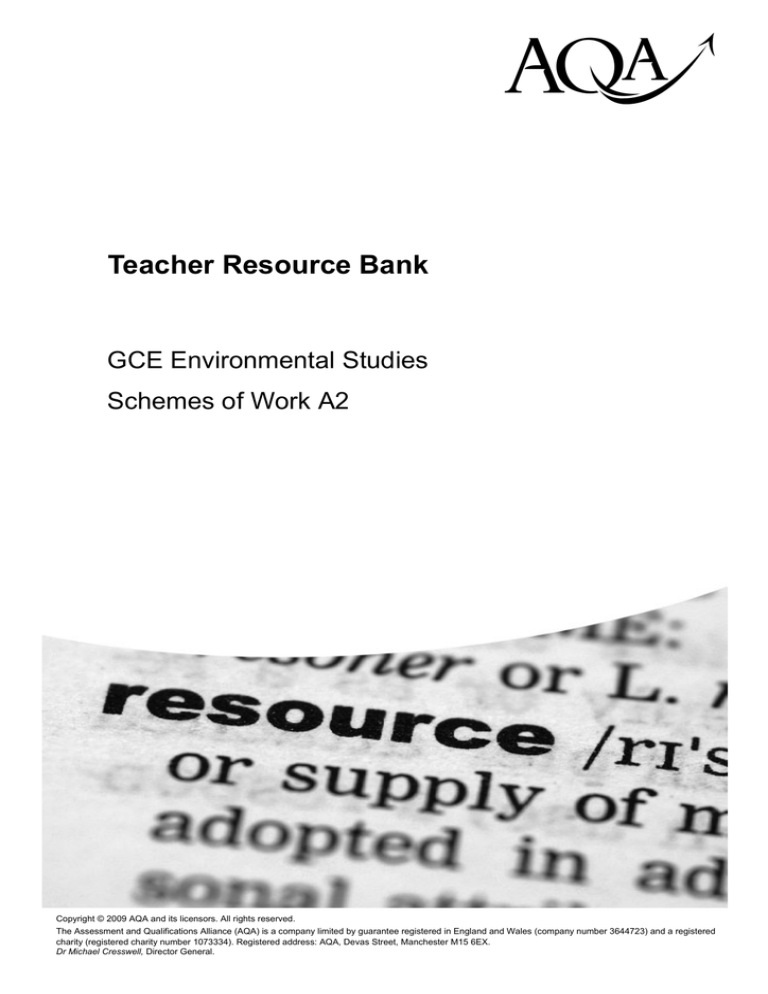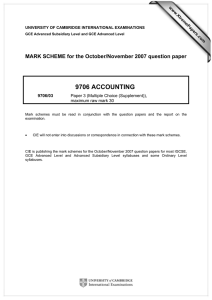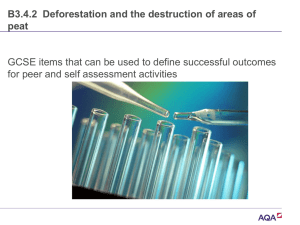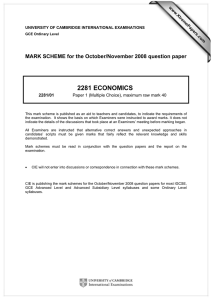
hij
Teacher Resource Bank
GCE Environmental Studies
Schemes of Work A2
Copyright © 2009 AQA and its licensors. All rights reserved.
The Assessment and Qualifications Alliance (AQA) is a company limited by guarantee registered in England and Wales (company number 3644723) and a registered
charity (registered charity number 1073334). Registered address: AQA, Devas Street, Manchester M15 6EX.
Dr Michael Cresswell, Director General.
Teacher Resource Bank / GCE Environmental Studies / Schemes of Work A2 / Version 1.0
A2 Environmental Studies
Schemes of work (Units 3 and 4)
These Schemes of Work are intended to support the information available in the
Specification and Teachers’ Notes. The Specification clearly identifies the topics to
be covered and the required details and terminology. The Teachers’ Notes give
further guidance, providing suitable examples that may be used to illustrate subject
principles.
These Schemes of Work provide a suggested timescale for covering the specification
content and an approach that may be used. The suggested time allocation is for
coverage of the specification content. Some time has not been allocated, to allow
time for induction, formal assessment, trips and revision.
The A2 course builds on the principles studied in the AS course. These principles are
applied to important problems and used to create links between the various topics
that make up the subject: when a candidate (for example) can explain why the use of
minerals in MEDCs causes energy use that causes pollution that impacts on wildlife
conservation in LEDCs then they truly understand the holistic nature of the subject.
The A2 course also allows a greater emphasis to be placed on how environmental
problems and their solutions can be related to the lifestyles of individuals.
It is important that the synoptic nature of the subject should focus on the optimism of
solutions to problems rather than just the seriousness of the consequences if the
problems are not addressed.
The specification has been written to allow candidates to develop an understanding
of the key issues without unnecessary repetitive coverage of a range of similar
examples. Where the specification includes a specific example then this should be
covered. Where no example is stated then teachers and candidates are free to
choose any suitable example to illustrate the principle involved. If an example is used
in the exam that is not stated in the specification, candidates should be able to gain
full credit by applying their knowledge of general principles to an unfamiliar situation.
Details have been given where the content can be covered with a particular
emphasis or teaching approach.
There are many valid opportunities to develop topics and spend more time. Equally,
there are some more straightforward topics where students could gain most of the
knowledge by self-study with a reduced amount of time spent checking progress.
klm
Copyright © 2009 AQA and its licensors. All rights reserved.
1
Teacher Resource Bank / GCE Environmental Studies / A2 Schemes of Work / Version 1.0
Unit 3 ( ENVS3) Energy Resources and Environmental Pollution
Topic
Possible teaching approach
Additional notes
Energy use
¾ week
Discussion of how students use energy directly in their daily
lives and indirectly to provide the goods and services they
use.
Assess the changes to life that energy shortages would
cause.
Consider how changes in energy availability affect the
development of society.
Try to produce quantitative estimates to assess the significance of
different uses.
Identify items and activities that involve surprisingly large and small
amounts of energy.
Energy resources
¼ week
Produce a list of all energy resources and discuss whether
they are renewable or non-renewable.
Emphasise the importance of time-scales and that some
renewable resources can be depleted by over-exploitation or poor
management.
Non-renewable
energy resources
1 week
Do not cover all the facts about every resource. An
introductory overview may help to set the scene, but the
emphasis should be on the features that influence their
use:
• finite resources - and hence the unavoidability of
depletion.
• energy density - very high and therefore very useful for
high power applications and where a small fuel mass is
an advantage eg where it is transported.
• available resource - they are abundant but future
supplies depend on developing new technologies,
paying more or accepting greater environmental
damage.
• level of technological development
Emphasise how the choice of using non-renewable resources
(especially fossil fuels) stimulated the development of industrial
and affluent societies.
The equipment and appliances used may be specific to fossil fuels
which may make replacing them more difficult.
3.3.1 Energy
2
Some issues require little explanation, others can be covered using
specific examples eg:
• oil price rises in the 1950s, 1970s
• the choice by France to use nuclear power to avoid the
vulnerability of relying on oil to make electricity.
• the impact of the accident at Chernobyl (1986) on the
development of nuclear power.
• how the 'dash for gas' in the 1980s caused the almost
complete closure of the UK coal industry.
Copyright © 2009 AQA and its licensors. All rights reserved.
klm
Teacher Resource Bank / GCE Environmental Studies / Schemes of Work A2 / Version 1.0
Topic
Possible teaching approach
Additional notes
Non-renewable
energy resources
1 week
continued…
Technological developments may increase supplies but
these may be inhibited by the availability of easier or
cheaper alternative supplies.
• environmental impacts - the severity of each and how
they can be minimised should be understood (many
are covered later in the unit).
• political, trade, economic issues - how these can
inhibit or ease supplies.
• Britain's increasing reliance on imported oil as our reserves are
depleted.
• political deals that are struck to ensure future supplies.
• the exploitation of new reserves of oil and gas in the UK
requires new technologies.
• how subsidies and investments can influence the choice of the
resource used.
Candidates could each research a specific issue,
technological problem, location, impact or event to
illustrate a particular principle or provide a usable casestudy.
A table could be used to show the key issues and suitable
examples (already included) with a third column to be
completed with explanations.
Renewable energy
resources
1 week
klm
Do not cover all the facts about every resource. An
introductory overview may help to set the scene, but the
emphasis should be on the features that influence their
current use and their possible use in the future:
• intermittency - some resources may not be available
all the time and power supply can fluctuate.
• unreliability - availability may be unpredictable. Don't
confuse this with intermittency. Some intermittent
resources are very predictable.
• energy density - often lower than non-renewable
resources.
• ease of storage – often impossible.
• environmental impact - often low, but some cause
significant habitat change.
The focus should be on the features of renewable resources that
make it difficult to use them to replace non-renewable resources related to supply, use, impacts and economics.
It was easy for fossil fuels to become widely used because they
competed with less useful energy resources (eg wood and water
power). But the modern use of renewables competes with
technically developed use of fossil fuels, with the economies of
large-scale use and where most development costs were paid a
long time ago. The equipment that uses the energy has often
been developed to use particular energy resources (eg liquid
vehicle fuels).
Copyright © 2009 AQA and its licensors. All rights reserved.
3
Teacher Resource Bank / GCE Environmental Studies / A2 Schemes of Work / Version 1.0
Topic
Renewable energy
resources
1 week
continued…
Possible teaching approach
Additional notes
• geographical and locational factors - most are only
available in specific areas.
• suitability for current uses and level of technological
development - most are still being developed.
• economic issues - few renewable resources can
compete with well-established non-renewable
resources using current economic assessment
methods.
A table could be used to show the key issues and suitable
examples (already included) with a third column to be
completed with explanations.
Secondary fuels
½ week
Energy storage
½ week
The examples in the specification should be used (with others if
desired) to illustrate these issues.
The role of other technologies that could solve some of these
problems should be included eg energy storage and transport.
Electricity and hydrogen should be used to discuss how
more useful energy forms can be produced by energy
conversions (often a long sequence of them) starting with
harnessable primary fuels. The effect of energy
conversions not being 100% efficient on the amount of
energy delivered should be covered. A flow diagram of a
power station can be completed to show energy
conversions and conversion efficiencies.
Electricity can be used to illustrate the greater usefulness of
secondary fuels in terms of transport and range of applications.
Hydrogen can be used to illustrate how new technologies may
increase the usability of primary fuels eg renewable resources
that produce electricity.
Discussion of factors that cause different energy
resources and demand for energy to vary over different
time scales: seasons, weekly, daily, shorter time scales
and with changes in human activities.
Candidates could discuss and identify which energy forms can be
stored. If an available energy resource is to be stored then it must
be converted into one of these storable forms.
Candidates may consider how they use energy over a 24hour period, possibly using a time line, or as a graph if
quantitative data are used.
4
A discussion of economic costs should include an analysis of
costs caused and who pays them. The costs of pollution and
damage to human health (more serious for fossil fuels) are not
paid when fuels are paid for so they are effectively subsidised by
society.
Personal energy use can also include less obvious energy uses
such as fridges, chargers, appliances left on standby and energy
used to produce other goods and services eg water treatment,
road lights and industries that run 24hrs a day.
Copyright © 2009 AQA and its licensors. All rights reserved.
klm
Teacher Resource Bank / GCE Environmental Studies / Schemes of Work A2 / Version 1.0
Topic
Energy storage
½ week
continued…
Possible teaching approach
Additional notes
Current methods of storage should be considered eg
Pumped Storage HEP and related to the rates of change
in electricity supply and demand.
Conversion of electricity to storable chemical energy in
rechargeable batteries and as hydrogen can be
discussed.
Candidates can research the use of hydrogen as a
combustible fuel or in fuel cells as a method of using
energy from renewable resources.
The environmental
impacts of energy
use
The examples included in the specification should be
used to illustrate the range of impacts of energy
harnessing and use.
1 week
Spider diagrams could be drawn with details added to
'legs' to illustrate specific resources or types of damage
eg air pollution, habitat loss, aesthetics, access issues.
Future energy
supplies
The issues of supply problems and the use of new
technologies could be discussed, perhaps with individual
candidates being given different aspects to research.
This is the key issue in the study of energy resources: How can
we supply adequate energy supplies indefinitely without causing
unacceptable environmental harm?
An overall energy strategy (for the UK/world) could be
produced.
Many of these issues will be revisited when considering
sustainability in ENVS4
1 week
Exam questions could only require knowledge of the examples
stated in the specification, but some principles apply to many
resources and can be taught using convenient (local?) examples
and then applied to other resources.
The social, legislative, technological and economic
changes needed to achieve this could be discussed.
klm
Copyright © 2009 AQA and its licensors. All rights reserved.
5
Teacher Resource Bank / GCE Environmental Studies / A2 Schemes of Work / Version 1.0
Topic
Possible teaching approach
Energy use and
supply mix
Satisfying the energy demand of an individual, community
or country should be considered in the context of impacts
on
¼ week
Additional notes
Others: competition for resources, inappropriate choices
made by people deprived of energy, people affected by
pollution and habitat damage during extraction.
Energy
conservation
How avoiding waste and using energy more efficiently can
increase or extend supplies and reduce damage.
¾ week
3.3.2 Pollution
General properties
of pollutants
The properties should be covered to help understand why
particular pollutants cause specific problems.
2 weeks
Candidates could consider the scenario of a new
chemical produced by industry. What would they need to
know before they could judge whether it would cause
pollution. Guidance can be provided to help develop the
questions then link these to the names of the properties.
An understanding of the general properties of pollutants and how
the environment affects their behaviour will help with
understanding the problems caused by all the pollutants studied.
It should be possible to predict the problems once the properties
are known.
The features of the environment into which it is
discharged can be considered. Where would it go and
why?
Atmospheric
pollution
Acid rain, tropspheric ozone and smogs - causes and
effects.
1 week
6
Copyright © 2009 AQA and its licensors. All rights reserved.
klm
Teacher Resource Bank / GCE Environmental Studies / Schemes of Work A2 / Version 1.0
Topic
Possible teaching approach
Additional notes
Atmospheric
pollution control
The different control methods and how they are interrelated.
The link between the required technologies and the regulations
that ensure their implementation should be made.
The features of water bodies that affect the severity of
pollution.
No particular examples are required so any suitable ones can be
used.
¼ week
Water pollution –
features of water
bodies
¼ week
Pollutants of water
1 week
Candidates could study atlas maps to link pollution risk to
features such as industrial areas, areas of high population
density, shipping, river inflow and size of the water body.
Causes, effects and controls of pollution caused by oil,
pesticides, nutrients. A table could be drawn of the direct
and indirect effects of the different pollutants.
The emphasis should be placed on the pollutant properties and
environmental features.
Examples of impacts could be chosen to show the
different time-scales over which pollutants cause harm.
Water pollution
monitoring
The methods stated in the specification and expanded in
the teachers' notes should be covered to understand the
basics of how they work and why they are suitable for
their individual uses.
The practical difficulties of monitoring pollutants, where levels
may fluctuate greatly, requires the use of a range of different
methods.
The properties, effects and controls of heavy metals,
using suitable examples.
The similarity of the properties and impacts of the main heavy
metals means it in not necessary to study them all in detail.
Noise pollution
Sources, effects, controls.
1 week
Noise measurement.
The different sources of noise pollution have their own unique
features. The ways in which different interest groups can tackle
noise pollution should be considered: legislators, planners,
manufacturers, use industries, public.
½ week
Heavy metal
pollution
1 week
Candidates could draw a design of a
car/house/airport/factory that would minimise noise
problems.
klm
Copyright © 2009 AQA and its licensors. All rights reserved.
7
Teacher Resource Bank / GCE Environmental Studies / A2 Schemes of Work / Version 1.0
Topic
Possible teaching approach
Additional notes
Ionising radiation
Sources, effects, controls.
1 week
Draw a scale of a wide range of uses of radioactive
materials and activities that increase exposure, arranged
in order of most beneficial to least beneficial. Apply the
principles of Risk- benefit analysis to these.
Using a real or made-up map, create a Critical Pathway
Analysis for gaseous and liquid effluents. Suggest
suitable locations and materials that would be monitored.
Suggest how Critical Group Studies could be carried out.
Ionising radiation
Compare these with the procedures used by BNFL.
1 week
continued…
Solid wastes
1 week
The principles of pollutant properties and environmental features
studied at the start of the topic can be used here.
Sources, types and treatment methods for industrial,
agricultural and domestic solid wastes.
Discussion points:
How does the local authority dispose of domestic waste?
What recycling facilities are available? Are they easy to
use?
What could be done by the
Government/LA/retailers/manufacturers/
public to reduce solid waste disposal problems?
8
Copyright © 2009 AQA and its licensors. All rights reserved.
klm
Teacher Resource Bank / GCE Environmental Studies / A2 Schemes of Work / Version 1.0
Unit 4 ( ENVS4) Biological Resources and Sustainability
Topic
Possible teaching approach
Additional notes
Introductory discussion of how affluence levels and
lifestyles affect resource use and the maximum
sustainable population.
The issues raised here will be revisited at the end of the unit in
Sustainability (3.4.5).
3.4.1 Human
Populations
Human populations
½ week
Agenda 21 objectives could be used as a plenary
assessment of the issues raised.
3.4.2 Food Production
Systems
Nutrition
½ week
Agroecosystems –
introduction
½ week
Discussion of the foods we eat and what trophic level
they come from. These can then be related to the
productivity and efficiency of food production, as related
to food utilisation/the environment exploited and food
chain efficiency.
The simplistic view that human herbivores use the land more
efficiently than human carnivores can be misleading. Meat
production on land unfit for arable use or using waste products
may be a rational approach to food production.
Factors affecting the selection of food species discussion of why people eat what they do and why this
changes: what is eaten, where and how it is produced.
The choices that people make should be identified to
emphasise that many environmental impacts can be reduced
by making different choices.
Control of the food species and the environment.
The scientific basis of food production should be emphasised:
identifying limiting factors and using our knowledge to satisfy
these and improve production. This is developed further in the
next two sections.
klm
Copyright © 2009 AQA and its licensors. All rights reserved.
9
Teacher Resource Bank / GCE Environmental Studies / A2 Schemes of Work / Version 1.0
Topic
Possible teaching approach
Manipulation of the food
species
The cultural methods that influence productivity.
1½ weeks
Additional notes
The range of methods that are used to control the
genetic factors that influence productivity.
A discussion of the pros and cons of GM foods.
Hormonal control of food production.
This discussion can be used to emphasise the importance of
scientific objectivity in considering each argument
independently.
Control of the
environment
The range of environmental limiting factors that can be
manipulated to improve production.
1½ weeks
A table or spider diagram could be produced to identify
environmental limiting factors, how they can be
controlled and why these changes are effective.
A range of farming activities may be considered to see how
they change limiting factors eg ploughing, field drainage and
crop rotation.
Environmental and
social impacts of
agriculture
The range of environmental and social impacts of
agriculture can be considered and discussed in terms
of:
2 weeks
- scale of impact
The coverage here could focus on details, with a more
comprehensive approach taken in 'sustainability' later in the
unit.
- impact on human populations
- impact on the sustainability of agriculture.
Agricultural energetics
1 week
10
A study of productivity, efficiency intensive and
extensive methods and energy subsidies.
The effect on total global food production of using the inputs
unevenly with most being used on the farmland of MEDCs.
Copyright © 2009 AQA and its licensors. All rights reserved.
klm
Teacher Resource Bank / GCE Environmental Studies / A2 Schemes of Work / Version 1.0
Topic
Possible teaching approach
Additional notes
Social/economic/political The range of factors outside the farm that influence
factors which influence
production.
agricultural production
Discussion of the role that the public and organisations
½ week
can take in influencing food production and how these
could make agriculture more or less sustainable.
3.4.3 Aquatic Food
Production Systems
Fishing – Marine
productivity and fish
populations
The uneven productivity of different areas of the sea,
why this occurs and how it affects the potential for
catches.
Fishing methods
The impact of fishing on populations and how the
concept of Maximum Sustainable Yield can be used to
assess sustainability should be studied.
1½ weeks
Candidates should consider fish populations as a renewable
resource that can easily be depleted by irresponsible use.
Fishing techniques
Details of fishing techniques should only be covered if they aid
understanding of selectivity, environmental impacts and energy
inputs.
Environmental impacts
of fishing and fisheries
management
1 week
klm
Impacts on the target species and wider environmental
impacts should be considered.
Discussion of how the public, the fishing industry,
governments and other organisations can reduce
environmental damage.
Copyright © 2009 AQA and its licensors. All rights reserved.
11
Teacher Resource Bank / GCE Environmental Studies / A2 Schemes of Work / Version 1.0
Topic
Possible teaching approach
Additional notes
Aquaculture
The main methods used in aquaculture.
These principles may be understood most easily by studying a
single case-study.
1 week
The environmental impacts can be considered in terms
of the sustainability of aquaculture and the suggestion
that it can replace the harvesting of wild fish.
3.4.4 Forestry
Forest resources and
production
1 week
Discussion of the wide range of forest products used by
people in their everyday lives, the life-support services
they provide and the importance of sustaining these.
Production methods
Forests should be considered as a renewable resource
that require responsible management.
Deforestation
The causes and impacts of deforestation.
1 week
Discussion of the roles of different groups in causing
deforestation and how it can be reduced.
12
The different production methods should be considered in
terms of the range of products, ease of production, size of
harvest and environmental impact.
Economic and social issues should be considered, including the
responsibilities of the purchasers of forest products and the lack
of alternative choices for many communities in LEDCs.
Copyright © 2009 AQA and its licensors. All rights reserved.
klm
Teacher Resource Bank / GCE Environmental Studies / A2 Schemes of Work / Version 1.0
Topic
Possible teaching approach
Additional notes
Individual candidates could summarise the
sustainability of different aspects of lifestyles.
This section should be used to draw together principles and
details from all the sections of the specification.
3.4.5 Sustainability
Unsustainable lifestyles
½ week
Discussion of the changes needed to produce a more
sustainable lifestyle.
Attempts to achieve
sustainable
development
A group discussion could assess the methods that
could be used by different groups to develop more
sustainable lifestyles.
1 week
Discussion of the effectiveness of previous attempts to
increase sustainability.
Sustainability case
studies
Candidates could study a particular activity or industry,
consider aspects that are unsustainable and make
proposals that would increase sustainability.
1 week
Human populations
1 week
klm
The factors that influence population growth and the
social changes needed to achieve population stability.
These issues should be considered in terms of the
unsustainability of unrestricted population growth and the
uneven access to resources in perpetuating growth.
Copyright © 2009 AQA and its licensors. All rights reserved.
13




